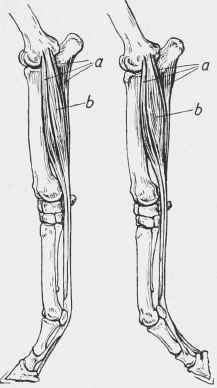Speed
Description
This section is from the book "The Horse - Its Treatment In Health And Disease", by J. Wortley Axe. Also available from Amazon: The Horse. Its Treatment In Health And Disease.
Speed
Speed is not due to the strength of the muscles, or we should find strong cart-horses with light bodies competing with the blood-horse. It is due to the rapidity with which the limbs can be straightened out in contact with an immovable body.
With few exceptions, it may be said that animals of great speed have long limbs and slender muscles, while those possessed of great strength have short limbs and thick muscles. A comparison between the race-horse and dray-horse, or between the greyhound and bull-dog, will serve to illustrate our meaning.
Upon the distance through which the centre of gravity is moved, in the various paces, depends the degree of fatigue produced. Where there is a period of suspension - all the legs being clear of the ground (Plate XII) - the centre of gravity is necessarily raised, and thus it follows that the fast trot, canter, or gallop over a given distance takes more out of a horse than the walk or slow trot, where there is no such period of suspension.
The raising of the centre of gravity in each of the paces where there is a period of suspension is exactly equal to its fall (or vice versa).
The changing of the centre of gravity from one side to the other is facilitated by the head and neck acting as a balance. The muscles connecting the head and neck with the trunk assist in raising the fore part of the body during locomotion.

Fig. 530. - Action of the Flexor Muscles and Tendons of the Fore-Limb.
a, Flexor pedis perforans. 6, Flexor pedis perforatus.
The weight of the body, says Le Coq, " transmitted by the canon bone upon the upper articulating surface of the long pastern, is the resistance to be overcome. The fulcrum is the ground at the toe of the foot, and the power acts upon the sesamoid bones, which are at the back of the pastern; the shortening of the flexor muscles being the cause of the straightening of the angle formed by their tendons." The manner in which this lever of the second order acts, keeping the distance between the power and the weight constant, will be seen in the accompanying illustration; but there is much variation in their distance from the fulcrum, owing to the difference of conformation in horses in respect to the slope of both pastern and hoof.
The nearer the toe to the canon bone the greater the mechanical power, as in the short-jointed draught-horse, while greater length gives more spring, and a long and sloping pastern is therefore esteemed in a saddle-horse, and particularly in the race-horse, as contributing to greater speed.
In addition to the flexion and extension enjoyed by the front limb, the hind one has an outward movement, due to the shape of the astragalus, and so designed to enable the stifle to move clear of the abdomen. This facing outward of the hinge does not affect the direct forward movement of the hind-foot, nor is the screwing action of an old and worn horse due to any failure of this portion of his mechanism.
Continue to:


